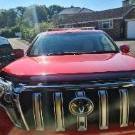-
Latest Postings
-
1
2012 Toyota Landcruiser Lacks power
Hi Mandy I have had something similar on a Nissan, no lights and no power. Does it make any unusual noises when putting your foot down? Pinking noise, whooshing or hissing noises? I take it you have had a code reader plugged in? Wondering if the MAF sensor is reading air intake incorrectly, giving this a clean with isopropyl would be beneficial anyway, but these usually these throw a light and go in to limp mode. You LC has not gone in to limp mode? can you build up speed with it? Also have you checked the car when the iginition is on that the CEL light actually works? -
0
‘97 Petrol 6 cyl ‘80 Series knocking/rattle below
Hi, Ive just joined, so Hello! I have had a knocking/rattle sound for a couple of months, sounds like a loose panel/body moving on chassis. Mechanic checked all this and i was told it is a loose baffle in fuel tank. Still makes noise when main tank is half full. Has anyone else had or heard of this issue please? Of course I’ll get another mechanics opinion before any major decisions, but my research shows so far that i have a BIG, expensive problem getting it fixed/replaced. Has anybody else dealt with this particular problem please? -
0
-
1
1989 Hilux Low Voltage
I,m pretty sure they run an external voltage regulator, mounted on the side in the engine bay, its been a while now so I'm not sure if the original had points inside which pit, stick and so on. Get yourself a fully sealed electronic one from the wreckers, as chances are someone has updated to cure symptoms like you are having, even one from another Toyota model eg Corona, will do, If yours is the original it will have a big black top on it, No more problems This is what you need; Buy Jaylec Voltage Reg 12V Denso Ext 026000-4050/4051/4070 For Toyota In589 15-867 Online | Rolan Australia -
0
-
0
Mr2 Spyder brake master cylinder
Does anyone know where to get a kit or master cylinder for a 2005 Spyder? Regards Jeff -
1
-
0
DIY Update GPS Maps on Toyota Corolla Ascent Sport 2017
Hi everyone, I own a 2017 Toyota Corolla Ascent Sport based in Perth, Western Australia. My car's navigation system currently runs on iGO Primo software (version 9.12.14.545514). I'm looking to update the maps and keep the entire system updated. I understand that the recommended method is to visit a Toyota dealer, but I'm interested in exploring if there's a DIY way to do this. Could anyone guide me through the process or provide any reliable resources or links? Here are the details of my current setup: Car Model: Toyota Corolla Ascent Sport 2017 Location: Perth, Western Australia Navigation Software: iGO Primo 9.12.14.545514 Specifically, I'd like to know: Where can I find the map update files that are compatible with my navigation system? What are the steps involved in transferring the map updates to an SD card and updating the system myself? Are there any risks or considerations I should be aware of before attempting a DIY update? I’ve looked through the user manual and some online resources but couldn’t find a comprehensive guide. Any help or pointers would be greatly appreciated! Thanks in advance! Best regards, -
1
2012 Toyota Landcruiser Lacks power
Hey guys we have recently purchased a 2012 200 series (cut down dual cab - extended) 240km on the clock It lacks power when accelerating and the gear changes are delayed when you put the foot down. blows very little soot when accelerating Nil lights on the dash. Injectors seem to be reading ok. Only fault code that popped up was C1201 Any input is much appreciated. -
1
1zz-fe engine rebuild
go to an jdm engine importer and buy a complete engine, much easier. You could even fit a 2zz ge into it
-





Recommended Posts
Join the conversation
You can post now and register later. If you have an account, sign in now to post with your account.